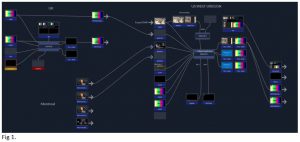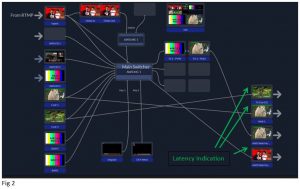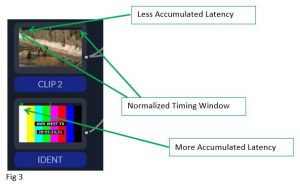SVG Tech Insight: Virtualizing Content Creation
This fall SVG will be presenting a series of White Papers covering the latest advancements and trends in sports-production technology. The full series of SVG’s Tech Insight White Papers can be found in the SVG Fall SportsTech Journal HERE.
The cloud is certainly top of mind. The increasing move towards remote production heightens interest in the cloud as both a technology and a service. The pandemic has accelerated this trend. Content originators are eager to trial Proof-of-Concepts, and move rapidly to on-air operations. Until now, remote production typically consisted of two teams, one at the venue and one at a central location. The pandemic challenges this model, stretching it to include the concept of production talent working from home with virtualized processing equipment in the cloud.
Grass Valley anticipated this three-position model of distributed cloud production based on technology trends. It was working with early adopters prior to widespread quarantine. If there is a silver lining to be found, perhaps it can be described by explaining the lessons learned with GV AMPP, Grass Valley’s Advanced Media Processing Platform.
AMPP is designed natively for the cloud. It is not an adaptation of the cloud, nor is it an attempt to have the cloud behave as an emulator of an on-premise facility. The simple three-position model could be considered as cameras and microphones at a venue, producers at home, and the virtualized application in the cloud. In the limit, there could be more than one of each position, in more than one geographic location. This immediately complicates the requirements on a number of levels, which can be categorized as Control, Monitoring, and Latency Management. Different producers must have an intuitive user interface, which provides them a coherent media experience and at the same time, allows for collaboration with additional producers.
GV AMPP consists of a control plane and a data plane. An essential concept with cloud technology is to include resiliency in preference to rigidity. Strong identity principles are used throughout both control and data planes. The control plane provides operators a single point of system entry, a unique identity, and therefore authentication and a high degree of security. There can be multiple control points, located where required. These control points need not be located where video is processed. The use of strong identity ensures proper coordination of data plane resources amongst control points. Just as operators need not be collocated, it is possible to locate video processing, or data plane, resources where desired. A processing engine could be located at the venue, in the cloud, or in a producer’s “home” based on system performance requirements.
At the same time cloud technology is adopted, the user interface has been designed to offer a familiar look and feel. Figure 1 is a screen shot of AMPP. There are three geographic locations. There are a number of feeds, or sources. Signals are monitored and displayed in a familiar way. One nice feature is that monitoring is shown at the point of analysis, rather than pushed to a monitor wall which can often be well down stream, and therefore, inaccurate. At the same time, the system is represented as a connected graph showing general location, or deployment, of sources, processing, monitoring and feeds, as well as the signal flow.
Each producer can see their necessary resources, which can include the collaborative resources of another producer. Interaction between producers is managed to ensure usability.
The data plane exploits a microservice architecture. Video processing is carried out by devices, each with strong identity. Devices can be coordinated to appear as a single piece of equipment and controlled by operators as if they were a single piece of equipment. Still, the equipment is really a virtual device often composed of numerous microservices that may perhaps be located thousands of miles away. By design, AMPP provides a user interface is that is suitably responsive for human interaction even with this underlying implementation.
Providing human operators with acceptable responsiveness is a challenge. Signal propagation is measured in time. This delay, or latency, can be annoying, so much so as to render the system unusable. AMPP data plane technology targets bottlenecks in the transport stream, codecs, and receiver design to ensure the lowest latency as well as coherent signal management. In the end, the producer is provided a satisfying, very useable, albeit virtual, creative experience.
In order to meet the latency requirements of a given system, certain parameters can be adjusted; conceptually trading between aspects of quality for gains in latency, or vice versa. As compute improves, so do codecs. A 1080P59 signal can be very useful for production decisions even when compressed to 5 Mbps. As available bandwidth grows, the number of possible sources at a given location will also increase. Increases in web scale, transport, and compute technology will provide for more sources, with higher quality as well as the ability to decrease latency over time. AMPP will natively scale with these developments in underlying technology.
Causality cannot be violated. As the number of functional positions and their locations increases, unique identity is an important tool. NMOS provides one scheme of using unique identity and time for each grain that makes up a flow of video essence. In the terminology of SMPTE ST 2110, each frame of video has a unique time stamp. One need only add a unique identity for each audio, video, and control essence stream.
It is now possible to form time coherent alignment of essence, as well as processing control to achieve a determined outcome in any geographic location. Care can be taken to manage timing requirements for a video production service operating at full bandwidth, a monitoring service using compressed signals, a production decision process (which generates a control sequence), and the like. In short, any task can be carried out in a timeline and associated with the necessary processing steps to create flexible workflows meeting the human factors requirements for a given production.
Because this system is cloud native, it can be easily torn down and re-configured to meet the demands of the next shoot, be it breaking news or live sports. Figure 1 shows one representation of an AMPP system. But, AMPP has any number of user-configurable views.
In a second view, shown here as Figure 2, system dynamics for latency management are represented as horizontal bar graphs. This is especially important where understanding critical signal timing is essential to on-air confidence for production operators. Again, this screen shot shows the connected graph of a system along with the signals, processes and locations used, thereby representing the system.
The green arrows above point out horizontal timing indicators located at the top of the signal monitors, which are really live icons. The length of the green bar represents the timing position within the timing window. Timing windows are established as part of the system configuration as-built, or deployed. They are shown normalized to fit the length of the video monitor icon to simplify visualization. The green bar then represents accumulated latency for a given signal at the exact point in the system shown by the icon.
In Figure 3, a close-up of the timing bars is shown. In all likelihood, the green bar length will be unique for each icon, or stream, represented. A shorter bar indicates less latency, a longer bar represents longer latency. The system operates acceptably when all the bars stay within the normalized window.
AMPP manages this process. The icons and green bars exist to ensure confidence and facilitate understanding of acceptable system operation. Bars will very likely never be identical. The bars in this case are not identical and do not extend to the limit of the normalized timing window. Both streams are well within the acceptable timing window for stable operation.
GV AMPP certainly faced design challenges. These challenges were reduced to the design goals, which have been discussed above as key to meeting our customers’ needs. In turn, the solutions were developed in tandem with early product adopters ensuring their needs were met. Using cloud native technology, including microservices, enables rapid turn-around for developing new features, new workflows, and new virtual devices. In another aspect, AMPP uses a true foundation of CORE applications or services. In this way, new applications, workflows, and devices all inherit the assurance of latency-managed, cost-optimized operations, which respect human factors.



